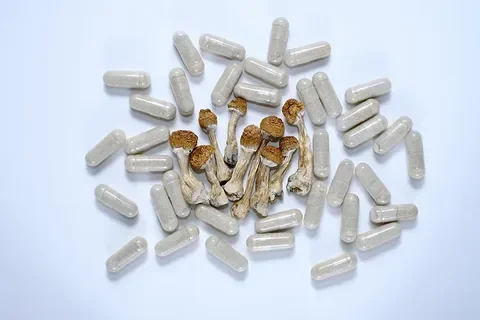What Are the Long-Term Side Effects of Microdosing Mushrooms?
In recent years, more people in the United States have become curious about microdosing mushrooms — a practice that involves taking very small, sub-hallucinogenic amounts of psilocybin-containing mushrooms. Many report microdosing mushrooms benefits such as increased focus, improved mood, and enhanced creativity. But as the trend grows, one question continues to surface:
What are the long-term side effects of microdosing mushrooms?
While research on mushroom microdosing is still relatively young, both scientific studies and user experiences offer some insight. In this article, we’ll explore what’s known about the possible long-term effects, discuss how to approach it safely, and answer common questions such as how to microdose mushrooms and how much is a microdose of mushrooms.
Understanding Microdosing Mushrooms
Microdosing mushrooms means taking a small fraction of a typical recreational dose of psilocybin — enough to potentially create subtle changes in mood, perception, and thinking, but not enough to cause hallucinations or strong psychedelic effects.
A microdose of mushrooms typically ranges between 0.1 and 0.3 grams of dried psilocybin mushrooms, though exact amounts vary depending on the individual’s body weight, sensitivity, and the potency of the mushrooms themselves.
People choose to microdose for various reasons:
Increasing productivity and focus
Reducing symptoms of anxiety or depression
Boosting creativity
Enhancing problem-solving skills
Supporting emotional well-being
While these microdosing mushrooms benefits are widely reported, it’s important to understand that most evidence is anecdotal and formal clinical studies are ongoing.
Potential Long-Term Side Effects of Microdosing Mushrooms
Long-term research is limited, but experts have begun to identify potential risks and side effects associated with mushroom microdosing when done consistently over months or years.
1. Psychological Dependency
While psilocybin is not considered physically addictive, some people may become psychologically dependent on the routine of microdosing. They may feel they cannot function optimally without it, which could interfere with their ability to cope naturally with challenges.
2. Emotional Fatigue
Some users report emotional “blunting” after extended periods of microdosing mushrooms. This could be due to the brain adapting to frequent stimulation of serotonin receptors, potentially making it harder to feel the full range of emotions when not microdosing.
3. Tolerance Build-Up
Frequent microdosing can cause the body to develop tolerance to psilocybin. This means the same dose becomes less effective over time, leading some to take higher amounts. Increasing dosage may unintentionally lead to mild hallucinogenic effects or negative psychological experiences.
4. Potential Heart Risks
Some research into other serotonin-affecting substances suggests possible links to heart valve issues with chronic, high-frequency use. While this is not proven for psilocybin, scientists urge caution until more is known.
5. Interactions with Mental Health Conditions
For individuals with bipolar disorder, schizophrenia, or a family history of psychosis, microdosing mushrooms could trigger or worsen symptoms. Long-term use may also subtly affect mood stability for sensitive individuals.
6. Legal & Occupational Risks
Even small amounts of psilocybin are illegal in many U.S. states. Long-term microdosing could expose someone to ongoing legal risk, which can have lasting effects on career and personal life.
How to Microdose Mushrooms Safely
If you are considering microdosing mushrooms, taking a mindful and measured approach is essential to reduce risks.
Step 1: Measure Accurately
A digital scale is crucial to ensure your dose is between 0.1 and 0.3 grams. This answers the common question: How much is a microdose of mushrooms? — it’s small enough that you should not experience hallucinations.
Step 2: Follow a Schedule
Many follow the Fadiman protocol (dose every 3rd day) or a 1-day-on, 2-days-off schedule to avoid tolerance buildup.
Step 3: Track Your Response
Keep a journal of mood, focus, creativity, and side effects. This can help you adjust dosing or frequency to minimize unwanted effects.
Step 4: Take Breaks
To avoid long-term side effects, take periodic breaks of several weeks or months to allow your brain chemistry to reset.
Step 5: Consult Professionals
Work with a healthcare provider or a professional trained in psychedelic integration to ensure the safest approach possible.
Microdosing Mushrooms Benefits vs. Risks
Many people in the U.S. are excited about the microdosing mushrooms benefits, which can include:
More consistent energy levels
Reduced social anxiety
Enhanced concentration
A sense of emotional clarity
However, balancing these benefits against possible long-term side effects is important. Not every user experiences negative effects, but awareness and moderation are key.
The Future of Research
As laws shift in places like Oregon and Colorado to allow regulated psilocybin use, scientists are now better able to conduct long-term studies on microdose mushrooms. In the coming years, we may see clearer answers about whether long-term microdosing mushrooms is safe, and under what conditions it works best.
Until then, those who choose to try mushroom microdosing should proceed with informed caution and responsible dosing.
Connect with Changa Institute for Guidance
If you’re interested in exploring how to microdose mushrooms in a safe, intentional way, Changa Institute provides education and guidance rooted in science and compassion. Our team can help you understand dosing, protocols, and integration practices for the best possible outcomes.
📍 Changa Institute
📞 15035151022
Whether you’re curious about the potential microdosing mushrooms benefits or want to learn more about possible long-term side effects, we can provide tailored, confidential support to help you make informed decisions.

